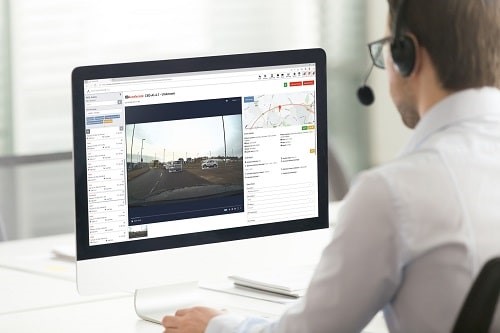Artificial intelligence is increasingly being used to reduce risks on the road, not only to the driver but also other road users, especially vulnerable ones.
Features
Artificial intelligence playing ever-greater role in cutting road risks
Artificial Intelligence (AI) is having an ever-greater influence on our everyday lives, so unsurprisingly it has a growing role to play within the fleet sector to help improve driver performance, support duty of care and cut costs. Moving forward, AI video telematics is expected to transform how vehicle operations approach road safety, making it easy to identify key areas of risk, reduce collisions and near misses, and ensure employees get home safely.
In the broadest sense, AI is about using machines to perform tasks that would typically have required some form of human intervention and demonstrate behaviours associated with human intelligence.
There are two types of technology – edge-and cloud-based – which will see AI become increasingly embedded in video telematics hardware and software. For edge-based solutions, the processing takes place close to the data source, such as a connected camera device, to provide real-time insight, whereas cloud-based solutions collect and process information in a centralised data centre for powerful post analysis.
 There are two types of technology – edge-and cloud-based – which will see AI become increasingly embedded in video telematics hardware and software. Photograph: iStock
There are two types of technology – edge-and cloud-based – which will see AI become increasingly embedded in video telematics hardware and software. Photograph: iStock
Advanced AI camera technology
AI-powered vehicle cameras, using Advanced Driver Assist System (ADAS), Driver Status Monitoring (DSM) and Blind Spot Detection (BSD) technologies, are already enabling fleet operators to maintain safety levels both for their drivers and other road users. By automatically monitoring hazards on the road and high-risk behaviours, these devices make it possible to provide real-time feedback straight to the driver.
Distractions such as mobile phone use, eyes away from road, smoking, eating and drinking, can be detected alongside other fleet risks, such as fatigue, tailgating and nearby vulnerable road users, so drivers can be encouraged to change potentially dangerous habits. In fact, in one international deployment of AI-powered video telematics, installed across 16,000 public sector vehicles, there was a reduction in risky driver behaviour of over 80 per cent within the first three months.
The latest intelligent detection cameras can identify and track vulnerable people where driver visibility is poor, and risk of injury high. These devices can establish the severity of risk dependent on the proximity of a worker, pedestrian or cyclist to the vehicle, activating internal and external alarms when they enter virtual exclusion zones. This provides the driver with increased time to react and warns other road users of the potential risk.
 Richard Kent, VP of global sales VisionTrack
Richard Kent, VP of global sales VisionTrack
Moving forward, advances in vulnerable road user (VRU) perception technology will enable AI-powered cameras to provide a nuanced understanding of human behaviour. Using machine learning techniques, it will be possible to train devices to accurately predict a person’s actions, and, as such, provide drivers with potential collision warnings that give them vital moments to avoid an incident. Backed by a dataset of hundreds of millions of human behaviours, the edge-based software analyses age, direction, speed and distraction to deliver a much higher degree of accuracy than traditional ADAS technology.
AI-powered post-analysis
Fleet managers can use the added insight provided by AI video telematics to better understand risk within their vehicle operations and take steps to address issues before they result in a driving incident. However, no vehicle operation has the time and resources to manually review every triggered collision, near miss or driving event, when video uploads can exceed hundreds per day. Due to the size and weight of many vehicles – especially vans, HGVs and specialist vehicles – dashcam g-force settings are highly sensitive to detect a collision, which results in large levels of generated events data.
Using AI to detect, monitor and analyse near misses and driver behaviour
Computer vision algorithms can now be used to review huge amounts of data, which means fleet managers are only being presented with information that requires immediate intervention.
AI post-analysis can, for example, help overcome the challenge of manually checking hours of downloaded footage by automatically validating in seconds whether a collision occurred and determining if any action is required. The technology will continue to evolve in the future to detect, monitor and analyse near misses and driver behaviour, which will support data-driven safety decision-making and problem-solving.
 VisionTrack Post Analysis
VisionTrack Post Analysis
AI post analysis uses advanced object recognition software to identify different types of vehicles, cyclists and pedestrians, making it possible to distinguish between collisions and false positives that can be generated by harsh driving, potholes or speed humps. This added layer of analysis enables rapid intervention and the ability to quickly summon emergency assistance, resulting in enhanced duty of care and driver welfare as well as reduced insurance claims costs.
The new generation of AI video telematics will ensure fleet operators can access the right information at the right time, presented in a way that enables them to achieve significant change and encourage drivers to operate in the most responsible manner.
By automating management processes, data analysis and incident detection, they can take advantage of intelligent solutions to keep drivers safe and reduce the number of collisions.
For more information see: visiontrack.com
Richard Kent is VP of global sales at VisionTrack
FEATURES

A year on – what have been the developments in competence management and the golden thread?
By Sofie Hooper, Association for Project Safety and Anthony Taylor, Resolve Risk Ltd on 03 July 2025
Last July the authors published an article in Safety Management where we looked at the expectations for those responsible for managing competence and those creating and managing the golden thread. In this edition we provide an update on both these key requirements of the Building Safety Act/Fire Safety Act’s ‘new regulatory regime’ including for higher-risk buildings (HRBs).

Stars, stripes and safety
By Belinda Liversedge on 02 July 2025
It seems like America today is rarely out of the news, particularly since President Trump won his second term. Our ‘special relationship’ with America has continued, with the country a strong pipeline for inspiration, products and trends.

The hidden risks of lithium-ion batteries
By Adrian Simmonds, QBE Europe on 01 July 2025
With UK fire services now tackling at least three Li-ion battery fires a day, it’s clear that stronger regulation and enforcement is urgently required to prevent the sale, use and modification of poor-quality and potentially dangerous batteries used in e-bikes and scooters.



